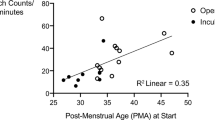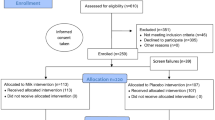Abstract
Objective
To determine the impact of maternal voice exposure on oral feeding in preterm infants.
Study design
Prospective, unblinded, 2-center intervention study of infants born 28 0/7–34 6/7 weeks gestation. Infants were exposed twice daily to maternal voice for 20 min before attempting oral feeding. Feedings were divided into groups consisting of Baseline, Intervention, and Follow-up feeds. The study was registered at clinicaltrials.gov (NCT05181020).
Result
29/37 (78%) mother-infant dyads consented for the study. 25 infants with 2051 feedings were included. Compared to the preceding Baseline, Intervention feeds were associated with an adjusted 7.1 percentage-point increase in oral intake (p = 0.036) and in post-hoc analysis a 71% increased likelihood of having the highest feeding readiness score (p = 0.003).
Conclusion
Exposure to maternal voice prior to enteral feeding is feasible and was associated with significantly improved oral feeding proportions in preterm infants.
Clinical trial registry
clinicaltrials.gov (NCT05181020).
This is a preview of subscription content, access via your institution
Access options
Subscribe to this journal
Receive 12 print issues and online access
$259.00 per year
only $21.58 per issue
Buy this article
- Purchase on Springer Link
- Instant access to full article PDF
Prices may be subject to local taxes which are calculated during checkout


Similar content being viewed by others
References
Pickler RH, Best AM, Reyna BA, Wetzel PA, Gutcher GR. Prediction of feeding performance in preterm infants. Newborn Infant Nurs Rev. 2005;5:116–23.
Caskey M, Stephens B, Tucker R, Vohr B. Adult talk in the NICU with preterm infants and developmental outcomes. Pediatrics. 2014;133:e578–584.
Scala M, Seo S, Lee-Park J, McClure C, Scala M, Palafoutas JJ, et al. Effect of reading to preterm infants on measures of cardiorespiratory stability in the neonatal intensive care unit. J Perinatol. 2018;38:1536–41.
Doheny L, Hurwitz S, Insoft R, Ringer S, Lahav A. Exposure to biological maternal sounds improves cardiorespiratory regulation in extremely preterm infants. J Matern Fetal Neonatal Med. 2012;25:1591–4.
Krueger C, Parker L, Chiu S-H, Theriaque D. Maternal voice and short-term outcomes in preterm infants. Dev Psychobiol. 2010;52:205–12.
Webb AR, Heller HT, Benson CB, Lahav A. Mother’s voice and heartbeat sounds elicit auditory plasticity in the human brain before full gestation. Proc Natl Acad Sci USA 2015;112:3152–7.
Chorna OD, Slaughter JC, Wang L, Stark AR, Maitre NL. A pacifier-activated music player with mother’s voice improves oral feeding in preterm infants. Pediatrics. 2014;133:462–8.
Shellhaas RA, Burns JW, Barks JDE, Hassan F, Chervin RD. Maternal voice and infant sleep in the neonatal intensive care unit. Pediatrics 2019;144:e20190288.
Griffith T, Rankin K, White-Traut R. The Relationship Between Behavioral States and Oral Feeding Efficiency in Preterm Infants. Adv Neonatal Care. 2017;17:E12–E19.
The jamovi project. jamovi. (Version 1.2) [Computer Software]. Retrieved from https://www.jamovi.org. 2020.
R Core Team. R: A Language and environment for statistical computing. (Version 3.6) [Computer software]. Retrieved from https://cran.r-project.org/. 2019.
Gallucci M. GAMLj: General analyses for linear models. [jamovi module]. Retrieved from https://gamlj.github.io/. 2019.
Barnett A, van der Pols J, Dobson A. Regression to the mean: What it is and how to deal with it. Int J Epidemiol. 2005;34:215–20.
Marsh H, Hau K. Multilevel modeling of longitudinal growth and change: Substantive effects or regression toward the mean artifacts? Multivar Behav Res. 2002;37:245–82.
Bapat R, Gulati IK, Jadcherla S. Impact of SIMPLE feeding quality improvement strategies on aerodigestive milestones and feeding outcomes in BPD infants. Hosp Pediatr. 2019;9:859–66.
Ludwig SM, Waitzman KA. Changing feeding documentation to reflect infant-driven feeding practice. Newborn Infant Nurs Rev. 2007;7:155–60.
Pinelli J, Symington A. Non-nutritive sucking for promoting physiologic stability and nutrition in preterm infants. Cochrane Database Syst Rev. 2005;4:CD001071.
Kirsch I, Lynn SJ, Vigorito M, Miller RR. The role of cognition in classical and operant conditioning. J Clin Psychol. 2004;60:369–92.
Sullivan RM, Taborsky-Barba S, Mendoza R, Itano A, Leon M, Cotman CW, et al. Olfactory classical conditioning in neonates. Pediatrics. 1991;87:511–8.
Loewy J, Stewart K, Dassler AM, Telsey A, Homel P. The effects of music therapy on vital signs, feeding, and sleep in premature infants. Pediatrics. 2013;131:902–18.
Feldman R. Parent-infant synchrony and the construction of shared timing; Physiological precursors, developmental outcomes, and risk conditions. J Child Psychol Psychiatry. 2007;48:329–54.
Saliba S, Esseily R, Filippa M, Gratier M, Grandjean D. Changes in the vocal qualities of mothers and fathers are related to preterm infant’s behavioural states. Acta Paediatr. 2020;109:2271–7.
Caskey M, Stephens B, Tucker R, Vohr B. Importance of parent talk on the development of preterm infant vocalizations. Pediatrics. 2011;128:910–6.
Author information
Authors and Affiliations
Contributions
AC—Conceptualized and designed the study, contributed to acquisition, analysis, and interpretation of the data, and drafted and revised the manuscript. JIH—Performed the statistical analysis and interpreted the data and drafted and revised the manuscript. SL—Conceptualized and designed the study, contributed to the analysis and interpretation of the data, and drafted and revised the manuscript.
Corresponding author
Ethics declarations
Competing interests
The authors declare no competing interests.
Additional information
Publisher’s note Springer Nature remains neutral with regard to jurisdictional claims in published maps and institutional affiliations.
Supplementary information
Rights and permissions
Springer Nature or its licensor holds exclusive rights to this article under a publishing agreement with the author(s) or other rightsholder(s); author self-archiving of the accepted manuscript version of this article is solely governed by the terms of such publishing agreement and applicable law.
About this article
Cite this article
Chhikara, A., Hagadorn, J.I. & Lainwala, S. Effect of maternal voice on proportion of oral feeding in preterm infants. J Perinatol 43, 68–73 (2023). https://doi.org/10.1038/s41372-022-01493-4
Received:
Revised:
Accepted:
Published:
Issue Date:
DOI: https://doi.org/10.1038/s41372-022-01493-4



